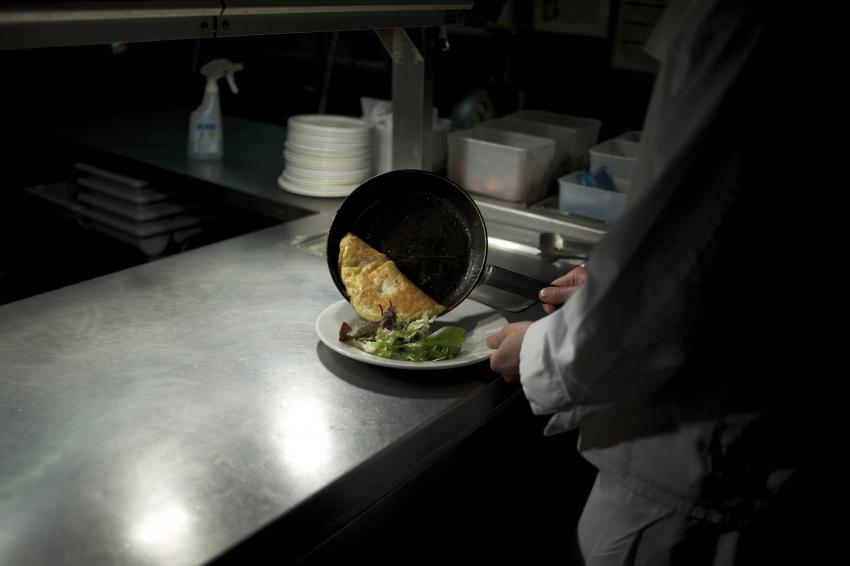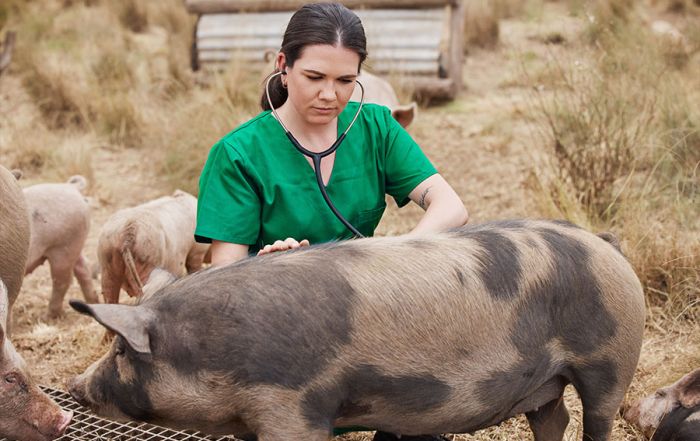The Incredible, Edible Egg Safety Quiz
 This nutritious, delicate food is a part of many food service menus as a main course and one of the most common ingredients. The U.S. Dept. of Agriculture says Americans consume an average of 234 eggs per person per year. Eggs have also been the source of some significant foodborne outbreaks in the U.S. from one specific type of Salmonella. While eggs are an important source of protein in the diet, an estimated 1 in 20,000 eggs in the U.S. supply will contain the SE (Salmonella Enteritidis) bacteria and can cause illness if eaten raw in foods or not thoroughly cooked before consumption.
This nutritious, delicate food is a part of many food service menus as a main course and one of the most common ingredients. The U.S. Dept. of Agriculture says Americans consume an average of 234 eggs per person per year. Eggs have also been the source of some significant foodborne outbreaks in the U.S. from one specific type of Salmonella. While eggs are an important source of protein in the diet, an estimated 1 in 20,000 eggs in the U.S. supply will contain the SE (Salmonella Enteritidis) bacteria and can cause illness if eaten raw in foods or not thoroughly cooked before consumption.
Egg Safety Practices — Because eggs can become contaminated internally from the hen, common egg-handling practices are now considered to be unsafe. These practices include temperature abuse (i.e. holding eggs and egg-containing foods at room temperature instead of under refrigeration), inadequate cooking, and pooling eggs to prepare a large volume of an egg-containing food that is subsequently temperature abused or inadequately cooked. Raw or under-cooked eggs pose a high risk for the elderly, children or immune compromised people.
What egg based products are risky? Foods which are lightly cooked such as custards or French toast are not safe if an infected egg was used. Avoid foods made with raw, uncooked eggs like Caesar salad, homemade mayonnaise, Hollandaise sauce, Béarnaise sauce, homemade eggnog, mousse, meringue, tiramisu, homemade ice cream, and raw cookie dough. These foods can be safely prepared by substituting pasteurized eggs for fresh whole eggs. Pasteurized eggs are available in whole, liquid or dried form. If pasteurized eggs are not available, a safe alternative is to use a recipe where the eggs are cooked.
Freshness of Eggs – How recently an egg was laid has a bearing on its freshness, but is only one of many factors. The temperature at which it is held, the humidity, and handling all play their part. These variables are so important that an egg one week old, held under ideal conditions, can be fresher than an egg left at room temperature for one day. According to the American Egg Board, the ideal conditions are temperatures that don’t go above 40°F and a relative humidity of 70 to 80%.
Proper handling of eggs at the producer level means prompt gathering, washing and oiling of the eggs within a few hours after laying. Most commercially produced eggs reach supermarkets or restaurants within a few days of leaving the laying house. As an egg ages, the white becomes thinner and the yolk becomes flatter. These changes don’t have any great affect on the nutritional quality of the egg or its functional cooking properties in recipes. Appearance may be affected though. When poached or fried, the fresher the egg, the more it will hold it’s shape rather than spread out in the pan. On the other hand, if you hard cook eggs that are at least a week old, they are easier to peel after cooking and cooling than fresher eggs.
The Egg Trivia Quiz
This will help you brush up on your egg knowledge with of course, a dozen questions. See how many you can get right without peeking.
Question 1: Prior to WWII, most egg production came from small farm flocks of 400 hens. By the early 1960’s improved technology shifted the U.S. production of eggs to flocks of 100,000 up to more than one million. Today, each of the laying hens produces: a) 100 eggs per year; b) 250-300 eggs per year; c) 400 eggs per year.
Question 2 : The egg shell and yolk color are indicators of nutritive value – True or False?
Question 3: How many USDA size classes are there for shell eggs? a) 4; b) 5; c) 6.
Question 4: How many USDA grades of shell eggs exist? a) 2; b) 3; c) 5.
Question 5: How often does a hen lay an egg? a) 10 hours; b) 25 hours; c) 48 hours.
Question 6: According to the 2005 FDA Food Code, the maximum temperature shell eggs should be received at: a) 45°F; b) 35°F; c) 50°F.
Question 7: The Food Code recommends shell eggs be cooked to a minimum internal temperature of 145°F – True or False?
Question 8: Is the air cell on the inside of an egg is one indicator of the age of the egg? Yes or No.
Question 9: Can humans get the “Bird Flu” or Avian Influenza from eating eggs? Yes or No.
Question 10: If a food service facility wants to serve lightly cooked eggs (over easy or sunnyside up, etc.) to a customer, do they have to inform the customer there is a risk? Yes or No.
Question 11: Shell eggs cannot be pasteurized in the shell. True or False?
Question 12: Salmonella can be on the outer shell of the egg. If the egg is contaminated in the shell with Salmonella, would it be in: a) the yolk; b) the white; c) both?
Answers
Question 1: B
Question 2: False. Egg shell and yolk color may vary, but color has nothing to do with egg quality, flavor, nutritive value, cooking characteristics or shell thickness.
Question 3: C. Jumbo, extra large, large, medium, small, and pee wee.
Question 4: B. Grades are AA, A, and B.
Question 5: The entire time from ovulation to laying is about 25 hours. Then about 30 minutes later, the hen will begin to make another one.
Question 6: A- 45°F.
Question 7: True.
Question 8: Yes –As the egg cools gets older, the inner shell membrane separates and creates the air cell. It is also an indicator of the grade of the egg.
Question 9: No. According to the FDA, there is no evidence that anyone has been infected with the Asian bird flu or other bird flu virus by eating properly cooked eggs or other cooked poultry products derived from infected birds.
Question 10: Yes. According to the FDA Food Code, the “Consumer Advisory says the customer must be informed.
Question 11: False. Eggs can be pasteurized with the shell intact, but the cost is slightly more. Pasteurized eggs must be refrigerated and still treated as a potentially hazardous food.
Question 12: C. Although it is possible for Salmonella to be in both, the yolk is more likely to contain the bacteria. The white does not readily support bacterial growth.
***
About the Author: Lacie Thrall

This information is provided as a general guideline and is not intended to be, nor does it, constitute legal or regulatory advice. Additional Federal regulations may apply to your particular circumstances. State, regional and local laws, ordinances and regulations may also apply.
Never Did I Ever…
Yes, I know the real game is “never have I ever”, but that phrase didn’t work [...]
Understanding Food Contamination in Foodservice Operations
Within this blog, I’ve provided a lot of details about the finer points of food safety [...]
The Antibiotic Debate in Our Food Chain
The discovery of antibiotics in medical science is regarded as one of the most important medical [...]
Exposing the Risks of Raw Milk
When I began my career in the food safety area several years ago, I never dreamed [...]









